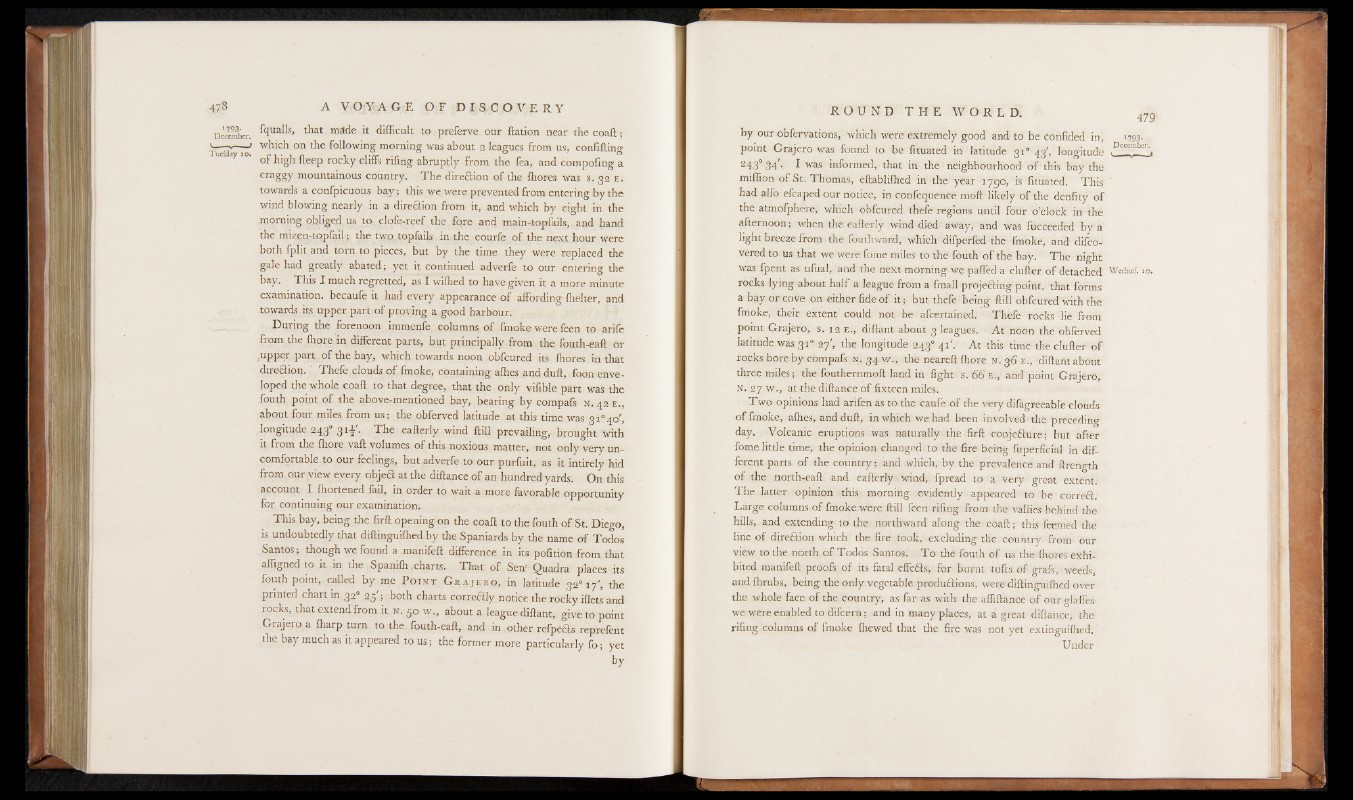
December ^ ua^s> that m^de it difficult to preferve our ftation near the coaft;
which on the following morning was about 2 leagues from us, confifting
y of high lleep rocky cliffs riling abruptly from the fea, and compofing a
craggy mountainous country. The direfilion of the (hores was s. 32 e.
towards a confpicuous bay; this we were prevented from entering by the
wind blowing nearly in a direction from it, and which by eight in the
morning obliged us to clofe-reef the fqre and main-topfails, and hand
the mizen-topfajl; the twp topfails in the courfe of the next hour were
both fplit and torn to pieces, but by the time they were replaced the
gale had greatly abated; yet it continued adverfe to our entering the
bay. This I much regretted, as I wifhed to have given it a more minute
examination, becaufe it had every appearance of affording fhelter, and
towards its upper part of proving a good harbour.
During the forenoon immenie columns of fmoke were leen to arile
from the fhore in different parts; but principally from the fouth-eaft or
,-upper part, of the bay, which towards noon obfeured its fhores in that
direction. ' Thefe clouds of fmoke, containing alhes and dull, Toon enveloped
the whole coaft to that degree, that the only vifible part was the
fouth point o f the above-mentioned bay, bearing by compafs N.42E.,
about four miles from us; the obferved latitude at this time was 3i°4o',
longitude 243° 31-i'. The eafterly wind ftill prevailing, brought with
it from the fhore vaft volumes of this noxious matter, not only very uncomfortable
to our feelings, but adverfe to our purfuit, as it intirely hid
from our view every objea at the diftance of an hundred yards. On this
account I Ihortened fail, in order to wait a more favorable opportunity
for. continuing our examination.
This bay, being the firft opening on the coaft to the fouth o f St. Diego,
is undoubtedly that diftinguifhed by the Spaniards by the name o f Todos
Santos; though we found a manifeft difference in its pofition from that
afligned to it in the Spanilh .charts. That o f Sen'-Quadra places its
fouth point, called by me P o in t G r a j e r o , in latitude 32“ 17', the
printed chart in 32° 25'; both charts correftly notice the rocky iflets and
rocks, that extend from it n. 50 w., about a league diftant, give to point
Grajero a fharp turn to the fouth-eaft, and in other refpeas reprefent
the bay much as it appeared to us; the former more particularly fo ; yet
by
by our obfervations, which were extremely good and to be confided in, '793-
point Grajero was found to be fituated in latitude 31° 43', longitude lDcC(1^^cr~-
243° 3 4 - I was informed, that in the neighbourhood o f this bay the
miffion o f St. Thomas, eftablifhed in the year 1790, is fituated. This
had alfo efcaped our notice, in confequence moll likely of the denfity of
the atmofphere, which obfeured thefe regions until four o’clock in the
afternoon; when the eafterly wind died away, and was fiicceeded by a
light breeze from the fouthward, which difperfed the fmoke, and difeo-
vered to us that we were fome miles to the fouth of the bay. The night
was fpent as ufual, and the next morning we pafled a clufter of detached Wednef. 10.
rocks lying about half a league from a fmall projecting point, that forms
a bay or cove on either fide o f it ;■ but thefe being ftill obfeured with the
fmoke, their extent could not be afeertained. Thefe rocks lie from
point Grajero, s. 12 e . , diftant about 3 leagues! A t noon the obferved
latitude was 310 27', the longitude 243° 41'. A t this time the clufter of
rocks bore by compafs n. 34 w „ the neareft fhore n . 36 e .; diftant about
three miles; the fouthernmoft land in fight s. 66 E., and point Grajero,
N. 27 w., at the diftance of fixteen miles.
Two opinions had arifen as to the caufe o f the very difagreeable clouds
o f fmoke, alhes, and dull, in which we had been involved the preceding
day. Volcanic eruptions was naturally the firft conjeflure; but after
fome little time, the opinion changed to the fire being fuperficial in different
parts o f the country; and which, by the prevalence and ftrenvth
of the north-eaft and eafterly wind, fpread to a Very great extent.
The latter opinion this morning evidently appeared to be correCi.
Large columns.of fmoke were ftill feen riling from the vallies behind the
hills, .and extending to the northward along the coaft; this feemed the
line o f direffion which the fire took, excluding the country from our
view to the north of Todos Santos. To the fouth of us the Ihores exhibited
manifeft proofs of its fatal effeCts, for burnt tufts of grafs, weeds,
and Ihrubs, being the only vegetable productions, were diftinguifhed over
the whole face of the country, as far as with the affiftance of our glafles-
we were enabled to difeern; and in many places, at a great diftance, the
rifing columns of fmoke Ihewed that the fire was not yet extinguilhed.
Under